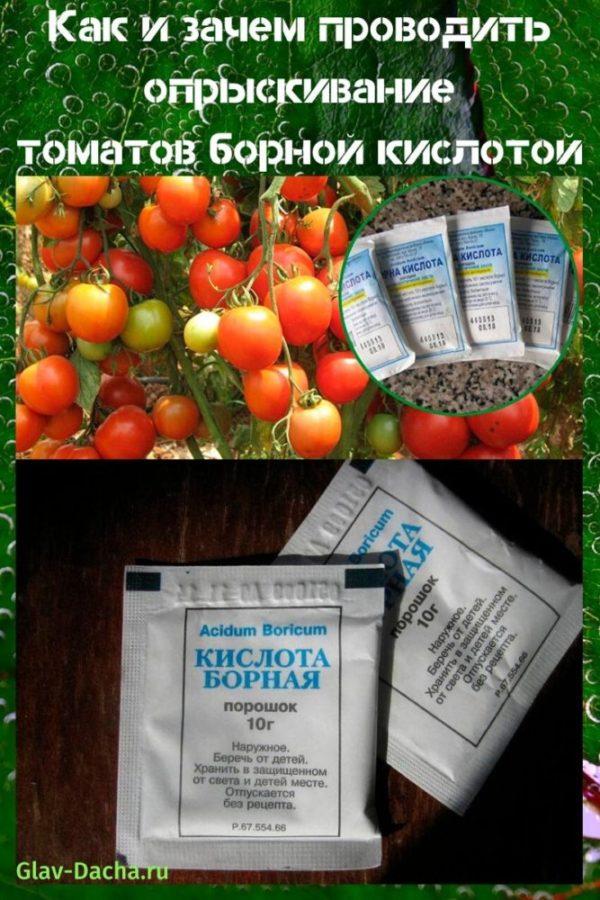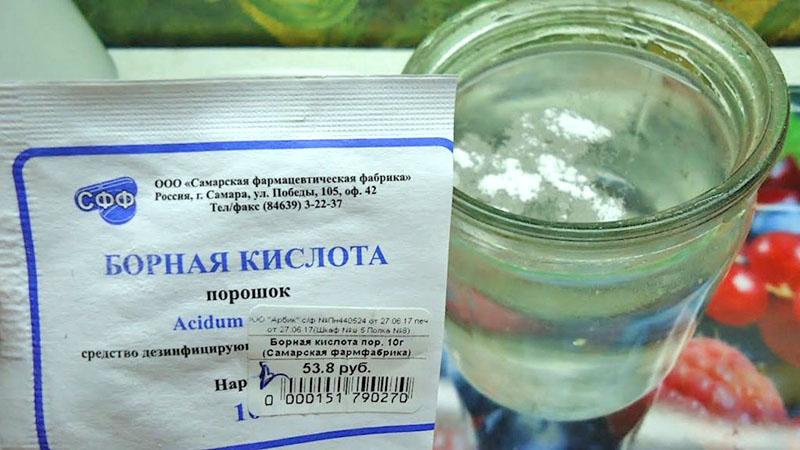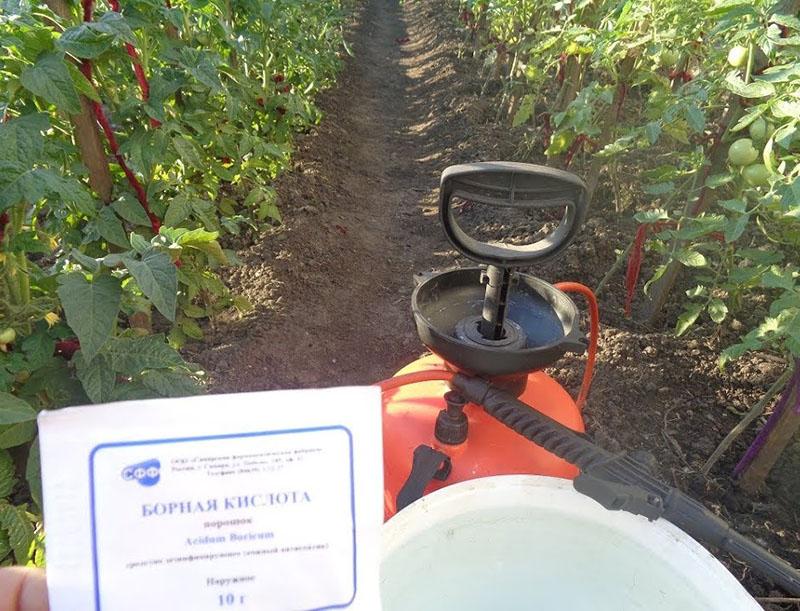How and why to spray tomatoes with boric acid
 Spraying tomatoes with boric acid is a must for every gardener. Without a sufficient amount of boron, plants will not be able to fully develop and bear fruit. But in this matter, the main thing is to know when to stop. Excessive intake of trace elements can harm tomatoes. Therefore, it is important to remember the rules for preparing a working solution and its use.
Spraying tomatoes with boric acid is a must for every gardener. Without a sufficient amount of boron, plants will not be able to fully develop and bear fruit. But in this matter, the main thing is to know when to stop. Excessive intake of trace elements can harm tomatoes. Therefore, it is important to remember the rules for preparing a working solution and its use.
Useful properties of boric acid for tomatoes
Boric acid is a white powder. It is odorless, antiseptic and insecticidal. For plants, it also acts as a source of boron. The lack of this trace element provokes the development of the plant chlorosis, dying off of the growth point, excessive branching, fragility of the stems and other problems.
Summer residents with many years of experience will easily answer the question of why to spray tomatoes with boric acid:
- to increase the number of buds on the bush;
- activating the formation of flower brushes;
- ensuring the simultaneous laying of fruits in all hands;
- preventing the development of diseases;
- reducing the likelihood of fruit rotting in conditions of high humidity;
- accelerating the ripening of tomatoes;
- increasing the sugar content of fruits.
Boric acid is recommended not only for spraying tomatoes, but also for protecting them from ants. To do this, it is mixed with sugar and a little water. The resulting paste is spread around the bushes. A few days later, the ants will die after eating the bait.
Signs of a lack of boron in tomatoes are the absence or shedding of ovaries, slow growth of leaves, excessive bushiness. In the presence of such manifestations, it is required to immediately spray the plant with boric acid.
Preparation of working solution

To spray tomatoes with boric acid, you need to prepare a working solution. To do this, adhere to the following sequence of actions:
- A liter of hot, but not boiling water is poured into the bucket. Its temperature should be around 70 degrees.
- Pour 10 g of acid into the water. Stir the solution until the powder is completely dissolved.
- Leave the liquid to cool. She should be at room temperature that is safe for the plants.
After that, you can proceed to processing plants.
The proportion of 10 g of powder per 10 liters of water is recognized as universal. If the solution is used to combat late blight, then the amount of boric acid can be increased to 15 g per 10 liters of water.
When spraying tomatoes with boric acid

You need to feed tomatoes with boron three times per season:
- Immediately after planting the plants in a permanent place. This is especially important in situations where the soil is highly depleted, it has a sandy or carbonate structure.
- In the phase of flowering and laying the ovaries. If the first feeding with boron was carried out, then this time only flower brushes are processed. Otherwise, spraying the tomato with boric acid for the ovary is carried out throughout the plant. You need to do this before the flowers open.
- During the period of active fruiting. As soon as small fruits appear on the bush, processing can be carried out.
 Boron is completely harmless to humans. Therefore, you should not be afraid that the acid gets on the already ripe fruits. It will be enough to rinse them in water and can be eaten.
Boron is completely harmless to humans. Therefore, you should not be afraid that the acid gets on the already ripe fruits. It will be enough to rinse them in water and can be eaten.
Any feeding should be in moderation.If tomato leaves curl up, yellow spots form on them - these are signs of boron overdose. In this case, potash fertilization will be required.
Processing rules

Inexperienced gardeners often wonder how to sprinkle tomatoes with boric acid correctly. This is not difficult. It is enough to follow a few recommendations:
- Work is carried out exclusively in calm weather. It is important to choose a time so that there is no rain for the next couple of days after spraying.
- Tomatoes are processed in the early morning or late evening. Solution droplets work like lenses. If you spray the leaves during the day, then when the sun hits the plant, burns will form.
- The diluted boric acid is poured into a sprayer. It is necessary to choose models that allow for finely dispersed irrigation. The solution should fall on the leaves not in drops, but in fog.
- Processing is carried out in the direction from top to bottom. The spray nozzle is held at an angle towards the bush. So the efficiency of feeding will be higher.
It is not worth increasing the dosage of the drug above the recommended rate. This will have the opposite effect. An excess of boric acid will destroy the beneficial microflora on the plant.
After spraying, the plants are observed. If they respond well to feeding, then after 10 days, re-irrigation is carried out.
Spraying tomatoes with boric acid in a greenhouse
 It is especially important to spray tomatoes with boric acid in a greenhouse. In greenhouses, plants often suffer from nutrient deficiencies. For processing, a solution is used, the temperature of which is close to the temperature of the soil.
It is especially important to spray tomatoes with boric acid in a greenhouse. In greenhouses, plants often suffer from nutrient deficiencies. For processing, a solution is used, the temperature of which is close to the temperature of the soil.
Irrigation of tomatoes is best done on a cloudy day or early in the morning. In the greenhouse, it is not recommended to spray the plants in the evening. This will lead to excess moisture at night, which will adversely affect the condition of the bushes.
The optimum temperature for boron assimilation is considered to be +25 degrees Celsius. If it is too hot in the greenhouse, it must be well ventilated before processing.
Useful cocktails for tomatoes based on boric acid solution
 The result from spraying tomatoes with boric acid can be enhanced by adding other components to the working solution.
The result from spraying tomatoes with boric acid can be enhanced by adding other components to the working solution.
Experienced gardeners note excellent results from the use of the following cocktails:
- Boric acid + iodine. Iodine promotes plant development and also prevents pests. To prepare a solution, 10 g of boric acid and 3 drops of iodine tincture are stirred in 10 liters of hot water. The resulting cocktail is poured into a spray bottle and the plants are processed on the leaf. Such dressings are carried out no more than three times per season.

- Boric acid + iodine + potassium permanganate. Adding potassium permanganate to the solution will prevent the appearance of fungal diseases and bacterial lesions. To prepare a cocktail in a bucket of hot water, dilute a tablespoon of boric acid and 1 g of potassium permanganate. After the solution has cooled, 20 drops of iodine tincture and 3 tablespoons of sugar are added to it. Plants are treated with this composition at the moment the ovaries begin to form.

- Boric acid + iodine + ash. Ash is a valuable source of various trace elements necessary for the normal development of bushes. To make a cocktail, a glass of ash is steamed in three liters of hot water. Leave to infuse for a couple of days. The resulting liquid is filtered. 3 teaspoons of boric acid, previously diluted in 200 ml of hot water, are added to it. 15 drops of iodine are introduced into the mixture. All components are thoroughly mixed.

When spraying tomatoes, you must not forget about precautions. You need to work with gloves. Wear a respirator before spraying. It is important to ensure that the solution does not get into the eyes and mucous membranes. You cannot stock up fluids for future use. The prepared top dressing should be used immediately.
Boric acid is a valuable fertilizer.It is very cheap, and therefore available to every gardener. The main thing is to follow all the processing rules and then the tomatoes will delight you with a bountiful harvest.